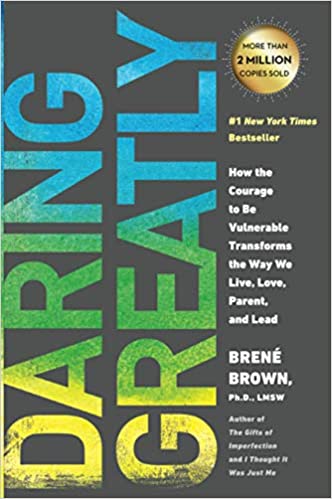“Every person understands and receives love in a specific language, one of five to be precise. The other four are just as important and offer other ways to express love to each other.”
These are the words of bestselling author and counselor Dr. Gary Chapman. Aided by his experience with real-life couples, Chapman mapped out the ways people express and need love into five ‘languages’.
Today, we’re bringing you the five love languages!

Daring Greatly
by Brene Brown
⏱ 13 minutes reading time
🎧 Audio version available
If you want to show your partner that you care, but you struggle to find ways to express your love in an intentional and meaningful way that will resonate with them, then pay attention!
A little background on Dr. Chapman– specifically his book, “The Five Love Languages.” This masterpiece sold a whopping 8,500 copies in its first year, which is four times what Chapman’s publisher expected. The next year, it sold 17,000 copies.
Two years later? The number exploded to 137,000. Since August 2009, the book has been a prominent name on the New York Times Bester Seller list. Today, it’s sold over 12 million copies since it was first published in 1992.
Dr. Chapman drew upon his years of experience taking notes as he counseled couples. During this time, he recognized a distinct pattern. Most of the time, couples were misunderstanding and misinterpreting each other and each other’s needs.
Then he discovered that there was a total of five love languages that resonate with people. And he discovered that most people’s love languages are very different from their partners’. When that happens, arguments, problems, and various issues pop up. They were just speaking different languages.
Words of Affirmation
The first language of love we have for you today is “Words of Affirmation.”
Words of affirmation mean any spoken or written words that uplift, support, confirm, and empathize with your loved one in a positive manner. One of the fundamental pillars of the “5 Languages of Love,” this language’s purpose is to express affection. And what better way than the spoken word that expresses praise and appreciation to tell someone you love them?
Kind words go a long way when speaking to someone who relies on affirmation to make sure that they are loved. Sometimes, it’s just as simple as hearing their partner say, “I love you.” Other times, you can be as creative as you’d like.
Leaving love notes, letters, cute text messages, voicemails– or even sending uplifting quotes are also under the umbrella of Words of Affirmation. Other examples include expressing gratitude for what someone did, such as a simple “Thank you,” and “I really appreciate what you did.”
Quality Time
Quality time can never lead you awry! As the fourth language of love, spending time with your loved one is essential for relationships.
Nothing expresses love more than giving someone your undivided attention. You’re showing them love, affection, interest, and more– all by scheduling time to hang out.
In order to spend some truly great quality time together, both partners need to turn off their phones, put away the tablet and iPad, make eye contact, and really listen when the other is speaking. People who find that “Quality Time” is their primary love language tend to be people who prefer quality over quantity– that means they feel the most loved when their partners are present and utterly focused on them.
As experts put it, “Spending time with your partner is about being together, paying attention to each other, sharing something meaningful together, and listening and communicating.”
Now, how can you achieve this? Examples include eating meals together, but how about taking things a step further and preparing dinner together and talking while someone preps the vegetables and the other stirs? Go on adventures, hikes, picnics, and do activities and projects that you both enjoy.
Physical Touch
The most obvious, and most visible way people express love is through physical affection. These people feel the most loved when they’re shown physical affection by their partner. That means things like holding hands, hugging, embracing, cuddling, touching their arms, massages, cheek caresses– you get the point.
As Chapman put it, “Be intentional about finding ways to express your love using physical touch: giving hugs, touching their arm or hand during a conversation; offer a neck or back rub.”
This person’s perfect idea of a date night might include ending up on the sofa, equipped with snacks, wine, a good movie, and their partner’s arms around them. There’s actually a scientific reason why physical touch is so important!
Being touched and having a sense of closeness creates a sense of comfort, which increases the level of neurotransmitters such as dopamine. Dopamine is known as the “happiness hormone.” Another hormone, “oxytocin”, is also increased, which is involved in human bonding.
Acts of Service
“Stumped as to what your partner needs?” author Chapman asks. Then this next language of love is the way to go! Acts of service are more like acts straight to your loved one’s heart. Performing an act of service makes everyone feel loved, appreciated, and grateful for their partner.
This means doing nice things for each other– uncalled for and unprompted nice things. It could be something like washing the dishes for them, offering to put gas in the car, serving them breakfast in bed, cleaning the house, making their favorite meal after a long day, going grocery shopping so they don’t have to, walking the dog, et cetera.
Find something that your partner struggles with and take it off their hands. And hey, if they did something nice for you, make sure to thank them to let them know how much you appreciate them.
What’s important is making your partner’s life easier and happier.
Receiving Gifts
This particular language may not be for everyone, but for those who use it as their primary way of expressing and receiving love, it’s incredibly important. The act of giving gifts is symbolic. It means that you thought of that person beforehand, made an effort to get, create, or buy something with them in mind– and it means that you had love, affection, and good intentions in your heart.
When your partner receives this gift, they’ll be appreciative of the time and effort put into it.
The best thing about this is that they don’t generally expect particularly expensive or massive gifts, such as diamonds and vacations. It’s the behind the scenes of getting the gift that matters.
Because you know what? That person who uses this love language tends to remember gifts, even every little one, that they have gotten in the past– simply because it stuck with them due to their appreciation. They treasure the fact that you went out of your way to get something that you know will make them smile. Chapman says,
“The thing that works best is picking the right gift that shows you understand your partner and the effort you made to express love. Think about finding a gift that your partner has been asking for or would enjoy receiving and plan for a special way of giving it; make it a surprise.”
Every now and then, it’s better to remind your loved ones of how much you love them– and with a gift, this reminder comes without necessarily having to break a sweat.
So what do all of these love languages result in? What are the benefits of implementing them in your relationships? A plethora of benefits!
They promote selflessness in the relationship. When you choose to commit yourself to learning your loved one’s language instead of trying to convince them to learn yours, you’re putting their needs before yours. And when your partner does the same, the relationship works.
In addition, and this is incredibly important, learning the five languages helps maintain intimacy. You’re both constantly learning about each other, connecting, and developing a deeper, more meaningful bond. When this happens, you will feel more intimately connected.
The love languages don’t just apply to romantic partners; they apply to your relationships with your friends, your children, and even your co-workers. Everyone expresses love differently, and your language may even change as you grow and mature, but learning each other’s languages?
It’s more than worth it. And you and your partner will be on the same level, not necessarily native in the same language, but you’re fluent in what your partner wants and needs.
What Is Snapreads?

With the Snapreads app, you get the key insights from the best nonfiction books in minutes, not hours or days. Our experts transform these books into quick, memorable, easy-to-understand insights you can read when you have the time or listen to them on the go.
